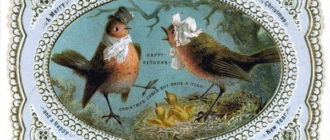
“Sunflowers” is a painting by the genius Vincent Willem van Gogh, created by him to decorate the interior. The work contradicted the dominant theory of color contrasts at the time. Yellow on yellow is a ridiculous combination, but it was this that became the hallmark of the post-impressionist. The plot of the work is laconic: a bouquet in an ordinary clay vase. The plane on which the vase is placed is not worked out, its texture is not important for the artist. The background does not carry any semantic load either: it is not a draped fabric and not an air environment, but simply a monochrome surface that does not create volume. The strokes, laid in vertical and horizontal rows, do not mix with each other and resemble a wicker mat.
Painting “Sunflowers” by Vincent Van Gogh – a symphony of sunny color
A vase is a rough vessel of small size compared to sunflowers. Its only decoration is the author’s signature above the thin dark blue line. Large flowers live independently in three-dimensional space: some petals are actively stretched forward, some tend downward, others are directed deep into the composition.
The master tried to demonstrate the breadth of the soul of humble creatures, for which not only the vase is small, but the whole canvas. The viewer has the feeling that the plants have nowhere to turn to show their beauty to the fullest. The inflorescences reach the borders of the picture, involuntarily moving away from the edge. A joyful mood and a charge of optimism gives the observer their golden yellow color. In the process of work, Van Gogh used the “impasto” technique: the paint was released from a tube immediately onto the surface of the canvas, after which a relief image was formed from it using a palette knife and a brush.
Title of the painting: “Sunflowers” (French Tournesols).
Author: Vincent Willem Van Gogh (1853-1890).
Year of writing: 1888
Size: 92.1 x 73 cm.
Style: Post-Impressionism.
Genre: Still life.
Technique: Oil painting.
Material: Canvas.
Location: National Gallery, London.
Vincent Willem Van Gogh is an outstanding Dutch painter of the second half of the 19th century.
His name is shrouded in a network of insane secrets and conjectures. Ironically, the genius, whose works today cost a lot of money, was able to sell only a few works during his lifetime. The master subtly felt the color, its depth and mood. Each shade was associated with a whole system of amazing images and formed into a multidimensional picture of the display of the surrounding world. Joy and well-being radiates yellow. In the works of the painter, he looks like a luminous aura.
Obsessed with the theme of “sunshine”, Van Gogh painted some stunning still lifes with sunflowers. The unusual appearance of the plant fascinated the artist with its charm and cosmic energy. The painter watched how this miracle of nature, always facing east in the morning, slowly turns to follow the sun after sunrise.
A series of eleven straightforward plots is conventionally divided into two cycles that are opposite in content.
This classification makes sense, since the whole world is divided into two diametrical poles. This is light and darkness, heaven and earth, life and death. The first still lifes depicting sunflowers were made in the French capital between August and September 1887.
They belong to the Parisian cycle, which combines works with plants placed horizontally on the canvas. These works are dominated by dark colors that create a feeling of sadness. The metropolitan society’s rejection of the strange, unsociable artist, his detachment, uncertainty, poverty – all this was reflected in the first four compositions. The round cut-off heads of flowers are thrown as if some outlandish living creatures are living out their last minutes. The crumpled petals look like the rearing fur of an unknown animal, the black centers of the bud look like big sad eyes, the stems look like painfully bent limbs. The longing of the end emanates from these flowers, but they resist fading, and the rest of their life still glimmers in them.
The second cycle was created a year later in Arles using a rich yellow-orange palette.
These include masterpieces with a vertical depiction of plants in a vase and personifying the author’s optimistic moods. Van Gogh painted a number of variations of the famous still life, which differed from each other in the number of flowers and the color of the background spatial plan. So the first version of this cycle is a composition of three sunflowers on a turquoise background.
It is not hard to see that some of the flowers look fantastic. They have a barely noticeable dark center surrounded by terry multi-tiered petals. In nature, such species are extremely rare. But the observant creator, of course, found unusual specimens in order to diversify his pictorial compositions with them. Later, in the process of crossing different varieties, the breeders managed to bring out the decorative terry sunflower variety Teddy Bear.






